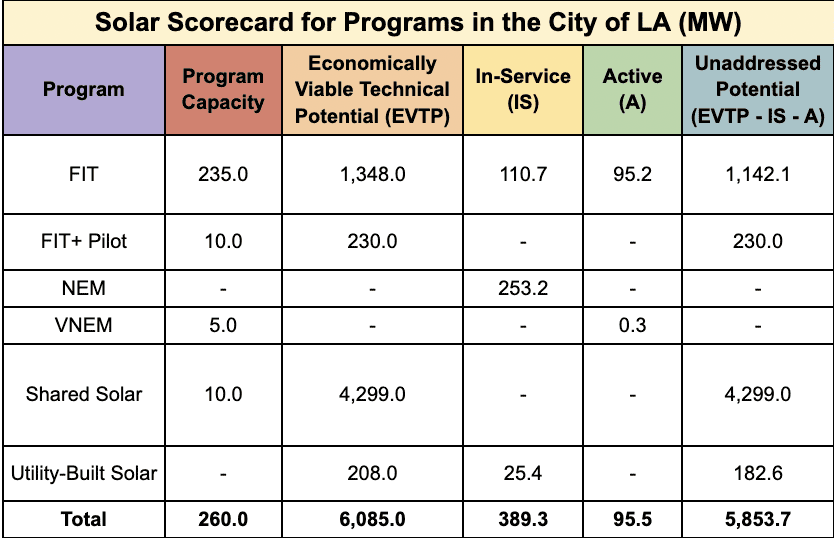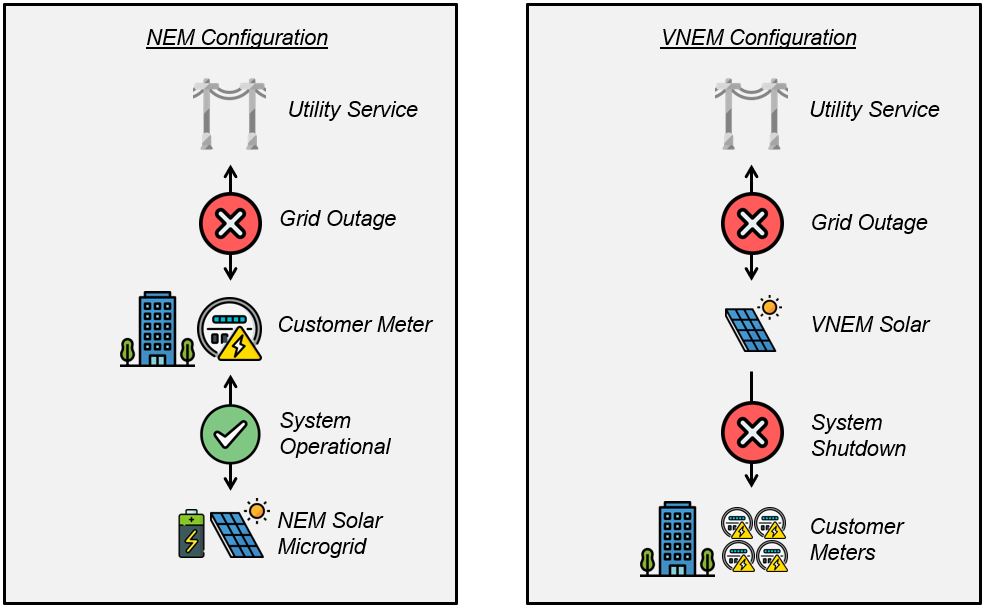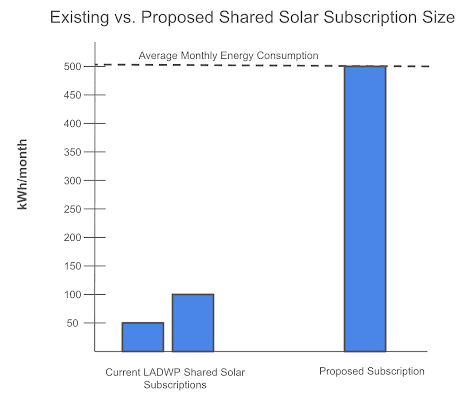
Decarbonize LA: Powering a Cleaner Future
This blog post by the Clean Coalition discusses the details of the Decarbonize LA Initiative.
Decarbonize LA: Powering a Cleaner Future
Turning Ambitious Clean Energy Goals into Measurable Action
The City of Los Angeles has set an ambitious goal: to be powered entirely by clean energy by 2035. Reaching this target requires more than just aspiration. It demands specificity, measurability, and strategic planning. Enter the Decarbonize LA initiative, a collaborative effort designed to inform and accelerate Los Angeles’ clean energy ambitions. Spearheading this initiative is a partnership between the Clean Coalition and Permacity Foundation, an LA-based nonprofit. The mission of the Decarbonize LA initiative is to provide comprehensive recommendations that accelerate LA’s decarbonization efforts, especially by unleashing solar on rooftops, parking lots, and parking structures — via straightforward and timely opportunities to deploy solar, Solar Microgrids, and Community Microgrids throughout the City of LA, and way beyond.
Measuring Solar Capacity of the LA Basin and Assessing Current Policies
The LADWP Power Strategic Long-Term Resource Plan calls for approximately 2,240 megawatts (MW) to 2,900 MW of in-basin solar to reach 100% clean energy by 2035, with projections of the National Renewable Energy Laboratory (NREL)’s LA100 Study estimating upwards of 4,600 MW of local solar deployment by this time. However, the Los Angeles Department of Water and Power (LADWP) has committed to developing only 1,500 MW of solar by 2030, falling significantly short of what is required five years before the city’s 100% renewable energy target. This gap indicates that LADWP’s plans are insufficient to meet energy ambitions.
In an economic analysis, NREL’s LA100 Study estimates that currently, it would be economically viable to develop ~8,300 MW to ~10,700 MW of rooftop and non-rooftop solar throughout the LA Basin, meaning that the energy value will at least make up for installation costs.

This chart illustrates the significant gap between LADWP’s current and planned solar energy capacity versus the capacity needed to achieve 100% clean energy by 2035, as well as the total economically viable local solar potential in the LA basin.
NREL’s LA100 Study sheds light on the importance of reevaluating current projects and policies in order to increase solar production in Los Angeles to meet the city’s clean energy goal. Drawing insights from LADWP’s Long-Term Resource Plan and NREL’s LA100 report, the Decarbonize LA team conducted a comprehensive assessment of current initiatives. From this analysis, six key strategies emerged as essential for achieving the mission, with the Feed-In Tariff (FIT)/FIT+, Virtual Net Energy Metering (VNEM)/VNEM+, Shared Solar, and Utility-Built Solar programs identified as immediate priorities.
The Decarbonize LA team prepared a table to convey the progress and potential of the different solar programs in place in the city of LA. The different metrics in this “Solar Scorecard” are derived from LADWP’s data and the LA100 study’s solar siting work, and the general format is inspired by the Permacity Foundation’s solar scorecard methodology.

Solar scorecard for Programs in the City of LA.
Sources: LADWP Website, LA100 Study Chapter 9, LADWP Data, Shared Solar Guidelines, UCLA Luskin Report
The following sections delve into the core initiatives and their role in steering Los Angeles towards a clean energy future. Following the development of project proposals, the team will share findings, objectives, and campaign details to inform a concrete action plan for the City of LA.
FIT and FIT+
One of the foundational initiatives of Los Angeles’ clean energy transition is the FIT program. The FIT program incentivizes commercial property owners to install solar on unused space on their property, including rooftops, parking lots, and parking structures. The introduction of paired battery storage in the FIT+ program further enhances the value created by each project by aligning exports with grid conditions, optimizing energy utilization and grid reliability benefits.
The FIT program enables commercial property owners to participate in solar energy production by allowing solar panels to be installed on their buildings. Rather than directly producing and selling the electricity themselves, property owners receive lease payments from a developer for hosting solar installations on their property. The solar developers sell the generated energy directly to LADWP. In return, LADWP commits to purchasing this energy at a fixed rate for up to 20 years, providing a consistent and long-term revenue stream for developers, while the property owners benefit from the lease payments.

Illustration of a FIT program, showing the energy and financial flows between solar sited at commercial properties and the utility grid.
This program is a win-win-win, financially incentivizing businesses to deploy solar while increasing the city’s renewable energy supply and supporting solar developers. FIT+, a program in its pilot stage with no projects currently developed, takes these benefits a step further by requiring paired solar+storage projects. Adding battery storage allows a project to store the solar energy produced when the grid is saturated with clean energy and sell the stored energy during peak demand hours when clean energy is scarce and the grid is congested, earning a revenue multiplier. Using the battery storage to “time-shift” energy not only increases the potential earnings but also helps stabilize the grid during high-demand periods. Furthermore, this program would allow energy to be consumed on-site, decreasing peak demand and providing resilience benefits during grid outages.

Histogram of rooftop solar potential for multifamily buildings demonstrates that relaxing the current minimum project size to 10 kW significantly benefits the amount of FIT participation.
(LA 100 Equity Report Chapter 4 page 18)
To optimize the FIT and FIT+ programs, the Decarbonize LA initiative proposes several key improvements. First, increasing the FIT rate from $0.145 per Kilowatt-hour (kWh) to $0.16/kWh for parking canopy systems in disadvantaged communities would incentivize greater solar adoption in these areas. Second, relaxing the current minimum project size requirement of 30 kilowatts (kW) for FIT projects down to 10 kW would expand participation to smaller multifamily buildings, significantly boosting program accessibility. Third, eliminating the cost-prohibitive Vista Switch requirement for projects larger than 1 MWac would reduce project costs and encourage greater investment. Currently LADWP requires developers to install Vista Switches for projects above 1 MW which can increase costs by $330,000 to $400,000, typically leading developers to limit project sizes to below 1 MW, or larger than 3 MW, the point at which the Vista Switch requirement becomes less of a financial burden. Finally, enhancing synergy between FIT and Net Energy Metering (NEM) programs by allowing FIT sites to utilize some energy on-site would provide greater flexibility and economic benefits for building owners. The FIT+ pilot has a 10 MW program size, although no projects are currently developed or contracted. While there is enormous potential for FIT+, the program’s success depends on tangible execution. Implementing the suggested improvements catalyzes the success of FIT+.
VNEM and VNEM+ with Storage
NEM offers economic benefits to customers via behind-the-meter (BTM) solar and storage. VNEM offers financial benefits of solar to multi-meter sites, including apartment dwellers who lack the property ownership to install solar on their own roof. Owners of multi-family buildings can install solar energy systems on their properties and sell the energy produced directly to LADWP. A portion of the revenue from this energy sale is distributed among tenants. While NEM configurations offer resilience benefits where a system can form a microgrid and island from the broader grid in the event of utility grid outages, VNEM configurations pose greater challenges when considering resilience. Since customers of multi-family apartments must have individual meters, VNEM solar is interconnected front-of-meter (FOM), eliminating resilience benefits during grid shut-offs but offering financial benefits. Master metering, where one meter is shared between an apartment building and energy is distributed to tenants via sub-meters, would allow apartment solar and storage to go BTM and thus protect against grid outages. However, master metering is not common practice within LADWP.

Comparison of NEM and VNEM configurations under normal operating conditions.

Resilience comparison between NEM and VNEM systems during a grid outage, showing NEM’s ability to maintain power while VNEM shuts down.
To enhance economic benefits of the VNEM program, the Decarbonize LA initiative proposes VNEM+, a VNEM configuration which includes battery storage. Enabling storage would increase revenue streams, with VNEM participants receiving increased compensation for exporting energy during peak times. VNEM+ would also yield grid benefits such as a reduced need for gas peaker plants and reducing energy lost during delivery via transmission lines. In addition, with the deployment of a grid isolation switch, resilience would also be promoted through a VNEM+. Establishing a VNEM+ program with solar and storage would help tap into the massive solar potential of multifamily dwellings in the Los Angeles territory, providing direct financial and resilience benefits to apartment-dwelling Angelenos.
Shared Solar (Community Solar)
The Shared Solar program represents an innovative approach to expanding clean energy accessibility in Los Angeles. By deploying solar within or near the LA basin, this initiative enables residents who previously lacked access to realize the benefits of solar, particularly those living in multi-family housing. Onsite solar is not always an option, especially if the distribution grid is constrained and costly grid upgrades may be required. Using a Shared Solar model, a resident can subscribe to a portion of a strategically-sited project’s output. The subscribed amount will be delivered at a fixed rate. This structure potentially insulates subscribers from rising utility costs. Clean energy credits from the solar production are applied directly to subscribers’ electricity bills, reducing overall energy expenses.
To maximize the impact of the Shared Solar program, the Decarbonize LA initiative proposes significant enhancements. Currently, the program serves 13,000 subscribers, a fraction of the 868,000 renter-occupied housing units in Los Angeles. Expanding the program’s size and scope is crucial. This includes increasing subscription rate options from the current 50 kWh/month or 100 kWh/month to 500 kWh/month, aligning with the average monthly consumption of an LA customer. Increasing the subscription amount will ensure that a great percentage of the customer bill is delivered at a fixed rate, to ensure that rate increases do not disproportionately affect low income customers.

The Decarbonize LA initiative proposes expansion of the Shared Solar program.
The initiative also calls for installing solar on all suitable land parcels in the built environment, including government-owned properties, recreation centers, educational institutions, hospitals, religious institutions, and multifamily residential buildings. Economic models indicate that deploying 1,050 MW of solar would be economically viable in these locations. Additionally, developing Shared Solar on affordable multifamily housing sites could make them eligible for a combined 50% Investment Tax Credit (ITC). This enhanced ITC, consisting of a 30% base credit plus an additional 20% for low-income residential building projects, would significantly reduce project costs for developers. These savings could potentially be passed on to subscribers in the form of lower subscription rates.
To further ensure equitable access, the Decarbonize LA initiative proposes establishing an additional 20% credit on the discount provided for low-income residents. This discount (e.g., the subscription rate), along with the existing subscription rate, would lower the price-per-kWh rate to $0.18/kWh for low-income customers, yielding immediate and substantial economic benefits for program participants by increasing average annual savings from $68 to $480.
These proposed improvements aim to transform Shared Solar from a limited program into a major contributor to Los Angeles’ clean energy landscape. The enhanced ITC reduces overall project costs, potentially lowering subscription rates for all participants, while the additional low-income discount ensures that the most economically vulnerable residents can access greater savings. By removing barriers to participation and increasing affordability, this initiative aligns with the city’s goals of equitable access to renewable energy and accelerated decarbonization.
Utility-Built Solar
While the city of LA has set ambitious clean energy goals, tapping into the solar potential on public buildings remains a challenge. The Utility-Built Solar program aims to address this by accelerating the deployment of solar on government-owned facilities. Under this program, 25 MW have been installed so far. LADWP has identified at least 52 MW of solar potential across public buildings like fire departments, police stations, libraries, and recreation centers. Additionally, a 2010 study estimates a total physical rooftop solar potential of 156 MW on government and nonprofit buildings in LA.
To catalyze Utility-Built Solar projects, the Decarbonize LA initiative proposes offering public buildings to solar developers as part of the city’s FIT program. This approach addresses the common challenge of securing rooftop agreements with public agencies, which can be a significant barrier for developers. By providing access to public facilities, the Utility-Built Solar initiative creates an opportunity for developers to expand their projects without needing to find suitable rooftops.
To further increase the impact of this program, the Decarbonize LA team, taking advice from the UCLA Luskin report, suggests bundling less attractive public sites with the most promising locations, requiring developers to take these projects as a package deal. Smaller projects require a higher dollar-per-watt cost to install solar whereas larger projects lead to a lower dollar-per-watt cost of installed solar due to economies of scale. Bundling the projects leads to a more reasonable average price that makes it feasible for developers to bid on. This strategy, similar to LADWP’s BlockFiT program, can help maximize the impact of the Utility-Built Solar initiative by ensuring that a broader range of public facilities are utilized for clean energy production. Utility-Built Solar represents an innovative approach to making solar more accessible.
Why Decarbonize LA?
Los Angeles needs to decarbonize with more focus and urgency. Current projects are not enough to reach the city’s goals. The Decarbonize LA initiative, through the enhancement of programs like FIT/FIT+, VNEM/VNEM+, Shared Solar, and Utility-Built Solar, promises far-reaching benefits for the City of Los Angeles. As these clean energy projects expand, they will create new jobs and opportunities in the renewable energy sector, fostering local economic growth. Moreover, the transition to clean energy will significantly improve air quality, leading to better public health outcomes, particularly in historically disadvantaged neighborhoods. Finally, these initiatives enhance energy resilience by diversifying power sources and reducing reliance on centralized grids. This increased resilience, coupled with the potential for lower utility costs, will provide tangible economic benefits to residents across the city. By pursuing these ambitious clean energy goals, Los Angeles is not just addressing climate change, but also investing in the health, prosperity, and resilience of its communities, paving the way for a more sustainable and equitable future. The Decarbonize LA initiative addresses the shortcomings of one city’s decarbonization efforts. There are many other cities that require similar assessments. This project serves as an example of cities falling short of their ambitious climate goals and how specific research and planning can accelerate progress.

